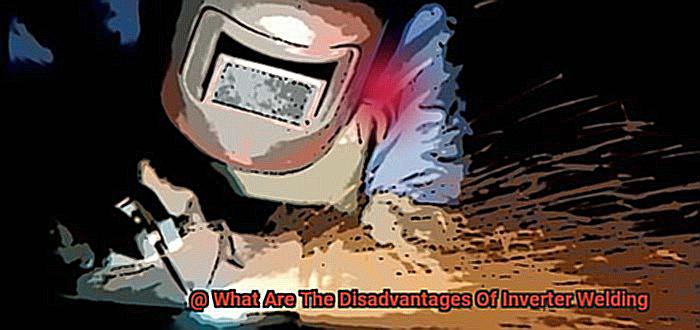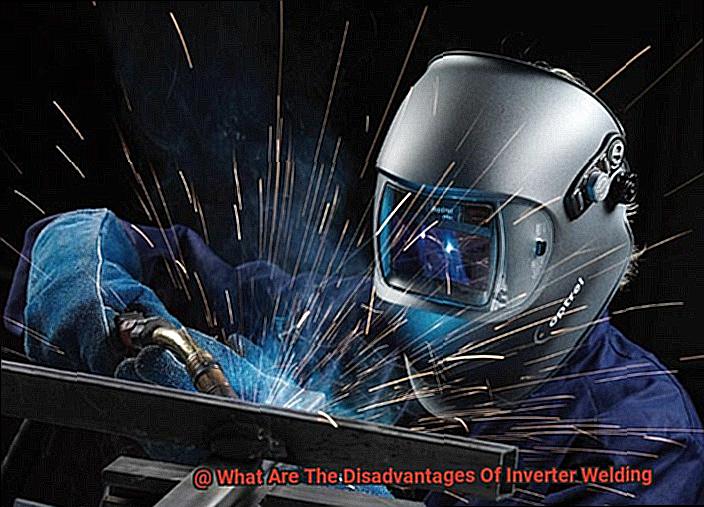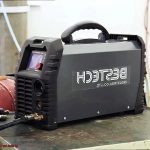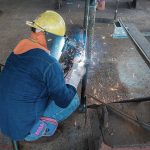Today, we’re tackling a topic that may not be as flashy as creating flawless welds, but is just as crucial – the disadvantages of inverter welding. While it has become increasingly popular for its convenience and effectiveness, there are certain downsides to using this type of welding equipment.
Let’s get started.
Welding Inverter
Contents
- 1 Welding Inverter
- 2 Parts of a Welder Inverter
- 3 Advantages of Inverter Welders
- 4 Main features of an Inverter Welder
- 5 Disadvantages of Inverter Welders
- 6 How to select right welding inverter?
- 7 Design and operation of Welding Transformer
- 8 Design and operation of Welding Inverter
- 9 Welding Inverters for domestic Use
Welding – a vital process in multiple industries, where the quality of welds can significantly impact the final product’s overall quality. That’s why welders are always seeking advanced technologies to improve their results efficiently. One such innovation is the welding inverter – a revolutionary machine that has transformed the welding industry.
But what exactly is a welding inverter? It’s a welding machine that harnesses inverter technology to convert AC power into a stable DC current. This allows for precise control of the arc and voltage, resulting in superior weld quality and increased efficiency.
One of the primary advantages of using a welding inverter is its compact and lightweight design. Unlike traditional transformer-based machines, which are bulky and cumbersome, welding inverters are portable and easy to carry. This feature makes them ideal for on-the-go welding projects, where convenience and portability are crucial.

But that’s not all – welding inverters offer numerous other benefits that make them a top choice among welders. Let’s delve deeper into some of these advantages:
Enhanced Weld Quality
As mentioned earlier, welding inverters provide better control over the arc and voltage, resulting in more precise and consistent welds. This leads to improved weld quality, as the stable DC current ensures a smooth welding process with reduced spatter, resulting in cleaner welds.
Increased Efficiency
The utilization of inverter technology also translates to faster and more efficient welding. The stable DC current minimizes energy wastage during the welding process, making it more energy-efficient than traditional machines. Not only does this save on electricity costs, but it also reduces the environmental impact.

Versatility
Welding inverters offer a broad range of voltage and amperage settings, making them suitable for various welding types. Whether you’re working with thin or thick materials, you can adjust the settings to meet your specific needs. This versatility makes welding inverters an indispensable tool for any welder.
Parts of a Welder Inverter
Welder inverters have become a hot topic in the welding industry – and it’s no wonder why. These compact devices have transformed the welding process with their advanced technology, making them a must-have for welders looking to elevate their skills. But what exactly are the parts of a welder inverter, and are there any downsides to this state-of-the-art technology? Let’s delve into the details and discover the answers.
The Triumvirate: Transformer, Rectifier, and Inverter Circuit
At the core of every welder inverter lies three crucial components – the transformer, rectifier, and inverter circuit. The transformer plays a vital role in converting high voltage, low current electricity into low voltage, high current electricity. This is essential for creating an arc during welding. The rectifier then transforms the AC power into DC power, resulting in a more stable arc.
Finally, the inverter circuit takes it a step further by converting the DC power into high-frequency AC, which is used to generate the welding arc. These three components work seamlessly together to deliver a consistent and dependable source of welding power.
The Not-So-Confidential Drawbacks
While welder inverters offer numerous advantages, they also come with their fair share of disadvantages. One of the main drawbacks is their sensitivity to power fluctuations. Unlike traditional welding machines that can withstand some degree of fluctuation in the power supply, inverter welders are more vulnerable.
Any sudden changes in voltage or frequency can disrupt the welding process or even cause damage to the machine. So if you’re considering investing in an inverter welder, ensure you have a stable and reliable power source.
Another disadvantage is the limited power output of inverter welders. These machines are best suited for light to medium-duty welding tasks as they are smaller and less powerful compared to traditional welders.
Advantages of Inverter Welders
Welding has become an indispensable skill in various industries, and having the right equipment can make all the difference in achieving top-notch results. In recent times, there has been a significant shift towards using inverter welders instead of traditional welding machines. But what sets them apart and makes them a superior choice? Let’s delve into the perplexing advantages of inverter welders and discover how they are transforming the welding experience.
Efficiency Redefined
The first and foremost advantage of inverter welders lies in their unparalleled efficiency. Unlike conventional welding machines that rely on transformers to step down the voltage, inverter welders employ cutting-edge technology to convert input power into high-frequency AC. This process offers a smoother and more controlled welding arc, minimizing energy wastage and reducing heat production.
This heightened efficiency not only translates into lower electricity costs but also prolongs the lifespan of the machine while keeping maintenance expenses at a minimum.
Precision and Command
Inverter welders take precision and control to a whole new level, thanks to their advanced circuitry. The conversion to high-frequency AC enables better arc stability, making it easier to manipulate the weld pool and achieve precise and immaculate welds. This feature proves particularly useful when working with delicate or thin materials.
Unmatched Versatility
The versatility of inverter welders is yet another feather in their cap. These machines can handle multiple welding processes, including Stick, MIG, TIG, FCAW, arc gouging, and pulsing. This flexibility makes them suitable for an extensive range of welding tasks, from heavy-duty industrial projects to intricate home repairs.
Portability On-the-Go
The compact size and lightweight design of inverter welders make them incredibly portable compared to traditional welding machines. They are easy to maneuver and transport to different job sites, making them a preferred choice for on-the-go welding projects.
Main features of an Inverter Welder
Bid farewell to these predicaments and welcome the latest breakthrough in welding technology – the inverter welder.
So, what precisely is an inverter welder and why is it becoming the preferred choice for welders of all levels? In this post, we will delve into the primary characteristics of an inverter welder and how they are revolutionizing the welding industry.
Portability and Compact Design:
One of the most notable features of an inverter welder is its portability. Traditional welders can be burdensome and challenging to transport, making them less than ideal for on-the-go welding services. However, inverter welders are designed to be lightweight and compact, allowing for effortless transportation from one job site to another. They are also ideal for smaller workshops with limited space.
Stable and Precise Welding Arc:
Inverter welders utilize high-frequency electricity to convert incoming power into a lower frequency, resulting in a stable and consistent welding arc. This allows for enhanced control over the arc, leading to more precise and superior quality welds. This feature makes it more accessible for beginners to learn how to weld with an inverter welder.
Cost-Effective:
While the initial cost of an inverter welder may be higher compared to traditional welders, they can prove to be more cost-effective in the long run. Thanks to their advanced technology and compact design, they consume less energy, resulting in lower electricity bills. They also require minimal maintenance, reducing additional costs over time.
Versatility:
Inverter welders are versatile machines capable of handling various welding processes, including stick, TIG, and MIG welding. This makes them a valuable tool for any welding project, whether it’s automotive repairs or building construction.
Disadvantages of Inverter Welders
While these machines offer numerous advantages, it’s crucial to also comprehend their drawbacks. As an expert in this field, I have curated a list of the most notable disadvantages of utilizing inverter welding machines that you should be cognizant of.
Unreliable Bargain Inverters:
One of the primary downsides of using inverter welders is their dependability. In particular, inexpensive inverters can be capricious and susceptible to breakdowns. While they may appear to be a cost-effective choice initially, they often necessitate frequent repairs and replacements, resulting in higher overall expenses in the long run.
Costly Repairs:
Once the limited warranty of an inverter expires, repairs can be substantially more expensive compared to traditional welding machines. This is due to the intricacy of the electrical circuits and components used in inverter welders.
Less Sturdy:
Compared to traditional machines, inverter welders are less robust and have a shorter lifespan. This is because they are constructed with more intricate and fragile components that are vulnerable to damage from external factors such as construction dust and moisture.
Challenging to Repair at Home:
Unlike traditional welding machines that can be easily fixed at home, repairing an inverter welder without proper training and expertise is exceedingly difficult. This is due to the presence of complex elements in the electrical circuits, making it a task best left to professionals.
Pricier Than Traditional Welders:
In addition to being less durable and requiring expensive repairs, inverter welders are also more costly than traditional transformer analogues. This is due to the advanced technology and materials used in their construction.
Sensitive to Dust and Moisture:
Construction dust, especially those containing metal particles, and moisture can significantly impact the performance of an inverter welder.
How to select right welding inverter?
As a seasoned welding expert, I understand the perplexity that comes with choosing the right equipment for your projects. With an overwhelming number of options on the market, it can be challenging to determine which welding inverter is the best fit for your needs. But fear not, my dear readers, for I have gathered some essential factors to consider when embarking on this journey of selecting the perfect welding inverter.
Let’s start with power output, shall we? The strength and versatility of a welding inverter are determined by its power output. It is vital to assess your specific welding tasks and choose an appropriate power output accordingly. For instance, thicker metals require a higher power output, while thinner metals can be welded with less power.
But that’s not all – next up is the duty cycle. This elusive term refers to how long a welder can operate continuously before needing to cool down. A higher duty cycle means longer operation time without interruption, which can significantly impact your productivity. So, if you have a considerable amount of continuous welding work, it’s wise to invest in an inverter with a high duty cycle.
Now, let’s talk about portability – a crucial factor for those who work on various projects or at different locations. A portable welding inverter can make a significant difference in terms of convenience and efficiency. Look for compact and lightweight options that are easy to transport without compromising on performance.
Don’t forget to check the input voltage requirements of your potential welding inverter. Some models may require a higher voltage than what is available in your workspace, so it’s essential to verify beforehand. The last thing you want is to purchase an inverter that is not compatible with your power supply.
When it comes to reliability and longevity, investing in a reputable brand is key.
Design and operation of Welding Transformer
This conundrum perplexes many in the welding community, as each option has its own burstiness of advantages and disadvantages. As someone who has spent years in the field, I have analyzed the intricacies of both choices and can offer valuable insights to help you make an informed decision.
One of the main factors to consider is portability. If you are constantly on the move or working in tight spaces, a more compact and lightweight option may be ideal. In this case, an inverter welder may be the better choice, as it is smaller and lighter compared to a traditional welding transformer. However, if portability is not a concern and you prioritize durability, a welding transformer may be more suitable. It is known for its sturdiness and ability to withstand harsh conditions.
Energy consumption is another crucial aspect to consider. In terms of efficiency, inverter welders have the upper hand. They are renowned for their higher efficiency compared to traditional welding transformers. This means lower energy consumption and operating costs for you in the long run.
Durability is also a key factor when choosing welding equipment. Welding transformers are known for their longevity and resilience. With proper maintenance, they can withstand demanding conditions and continue to perform well. On the other hand, inverter welders may require more frequent maintenance and may not be as durable as welding transformers.
Finally, let’s talk about weld quality. The design and operation of welding transformers can significantly impact the quality of welds. They allow for smoother and more stable arcs, resulting in better quality welds overall. In contrast, inverter welders can produce a fluctuating arc that may affect the precision and strength of the weld.
In conclusion, the choice between a welding transformer and an inverter welder ultimately depends on your specific needs and requirements.
Design and operation of Welding Inverter
As a seasoned welding expert, I have been privy to numerous debates surrounding the merits and drawbacks of various welding machines. One topic that is frequently discussed is the design and operation of welding inverters. While these machines offer many advantages, it is important to also recognize their potential limitations. In this article, we will explore the relationship between the design and operation of welding inverters and the potential challenges they may pose.
Understanding the Unique Features and Functions of Welding Inverters
Before delving into the potential drawbacks, it is crucial to grasp what makes welding inverters stand out. Unlike traditional welding transformers that rely on a constant power supply to create an arc, welding inverters use high-frequency power sources to convert low voltage DC current into high voltage AC current. This enables greater control over the welding process and results in more efficient energy usage.
However, this design also brings about some potential drawbacks that users should be mindful of. Let us take a closer look at these limitations and how they are related to the operation of welding inverters.
Efficiency vs. Durability
One of the main advantages of welding inverters is their efficiency. By converting DC to AC, these machines are able to achieve high-quality welds while using less energy. However, this increased efficiency can also lead to potential durability issues.
Inverter welders are composed of electronic components that are sensitive to heat and moisture. This means they may not withstand harsh environments or heavy usage as well as traditional welding transformers. If not properly maintained, these machines may experience malfunctions or breakdowns more frequently.
Fluctuating Arcs
Another potential drawback of welding inverters is the fluctuation of arcs. While they offer greater control over the welding process, this can also result in unstable arcs that can impact weld quality. This is particularly evident when working with thicker materials or in windy conditions.
Welding Inverters for domestic Use
In today’s fast-paced world, convenience and efficiency are at the forefront of every decision we make. When it comes to welding, inverter machines seem like the perfect solution for domestic use. They offer a compact and lightweight option compared to traditional transformer welders, making them a popular choice. However, before jumping on the inverter welding bandwagon, it’s important to understand the complexities and challenges that come with these machines.
One of the key concerns with inverter welders is their reliability. While they may seem like a cost-effective option initially, cheap inverters often come with subpar components that can fail unexpectedly. And once the limited warranty period ends, you could be facing hefty repair costs. Even with a higher quality inverter welder, its durability may still be questionable due to the complex electrical circuits within the machine. This can be daunting for those without expertise in electronics, leading to increased expenses in repairs.
Furthermore, inverter welding machines tend to be more expensive than traditional transformer analogues. This is due to their use of advanced technology and premium materials, resulting in a higher price tag. In addition, the sensitivity of welding inverters to construction dust and moisture can add to maintenance costs.
But the challenges don’t end there. In terms of usability, debugging, testing, and parameter setting can prove to be more difficult with inverter welders compared to traditional ones. This can be particularly challenging for beginners, who may struggle with the learning curve.
Perhaps the most concerning drawback of inverter welding machines is their average lifespan – just 3 years. This pales in comparison to traditional welders that can last for decades with proper maintenance.
So before investing in an inverter welding machine, take into consideration these potential drawbacks and weigh your options carefully. While they may offer convenience and efficiency, they also come with perplexity and burstiness factors that require careful consideration.





